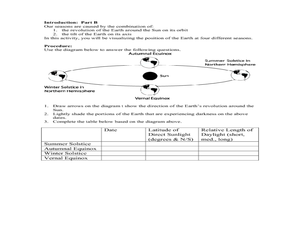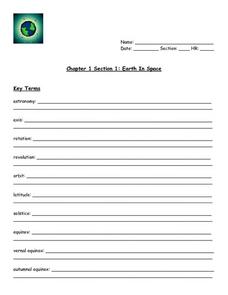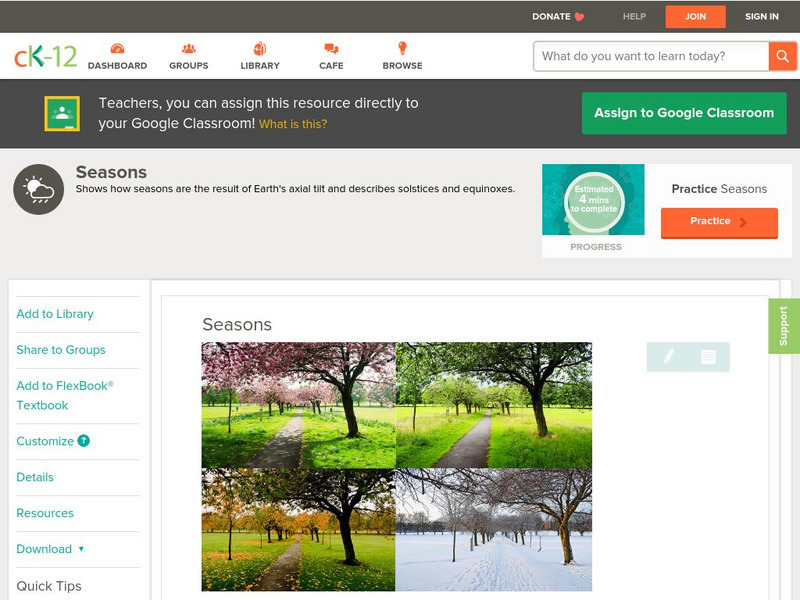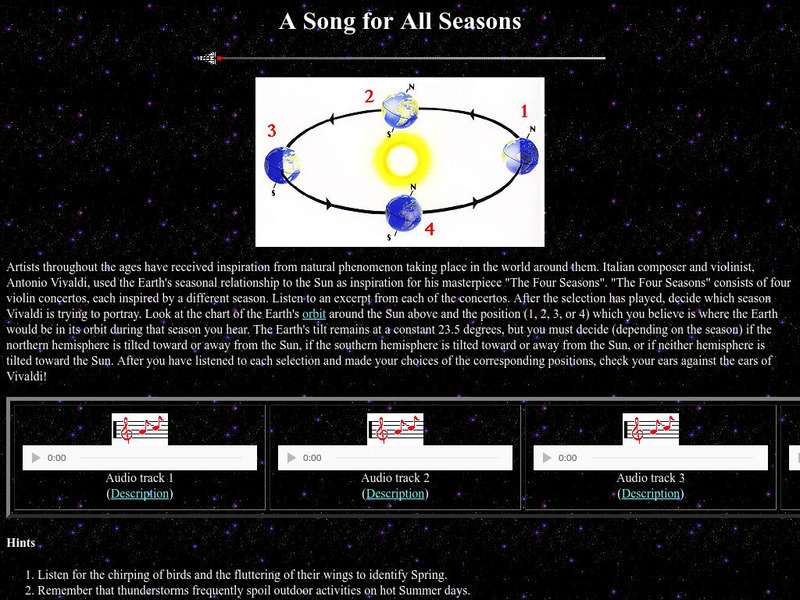Curated OER
The Sun's Path
Starting with questions about the tilt of the Earth and apparent motion of the sun, a learning exercise provides instructions on how to figure the paths of the Sun on certain dates. Learners answer three more questions, complete with...
Curated OER
Gotham Equinox
By looking at the direction of the parallel streets of New York and figuring which days the setting sun is directly visible along those lines, your class can calculate the degree and angle of the sun. A really nice lesson, giving a photo...
Curated OER
Motions and Their Effects
With a simple blackboard-style appearance, these slides list facts about the reason for the seasons, solstices, and equinoxes. It also touches on Kepler's first law of planetary motion. There are no pictures or graphics to help explain...
Curated OER
Suns Path and Seasons
Using a plastic dome to represent the hemisphere of the sky, your class is able to demonstrate the path of the sun at different points of the day and year. They use a protractor to record movement and answer questions about elapsed...
Curated OER
Earth in Space
In this reason for the days and nights on earth worksheet, students study the reasons the Earth has days and nights by answering 28 questions about earth's rotation, the equator, the relationship between the sun and moon, and the earth's...
Curated OER
A New Slant On The Seasons
Students identify how the tilt and position of the Earth causes the seasons. After a discussion of the seasons and when they begin. Using themselves as the objects in the universe, they role play how the rotational movement of the...
Curated OER
Solstice and Equinox Quiz
In this solstice and equinox quiz activity, students complete an on-line quiz, clicking on questions and matching answers, scoring 1 point for each correct answer. A printed version is available.
Curated OER
Solstice and Equinox
Students identify the dates of the solstices and equinoxes and how they relate to the various seasons on Earth. After discussing how the solstice and equinox affect the seasons, students use their bodies to demonstrate the how each...
Curated OER
Here Comes the Sun: A Solar/Terrestrial Tutorial
Students explore the sun and its effects on the environment. In this solar studies lesson plan, students follow a web tutorial to gather information about the sun, the seasons, the equinoxes, and solar heating.
Exploratorium
Exploratorium:seasons/shadows: Investigate How Shadows Shift Throughout the Year
Ancient Chacoans used shadows to tell daily time and seasons. Build a model that demonstrates the changes in Earth's tilt that affect the length of shadows relative to the sun that determines the seasons. The lesson plan uses everyday...
Georgia Department of Education
Ga Virtual Learning: Astronomy: The Earth
In this interactive tutorial students will learn what causes the seasons, diurnal cycles and how the constellations move through the sky. Learn we are able to see other planets and how astronomical events affected life on the Earth.
Scholastic
Scholastic: Web Hunt: Vernal Equinox
Learn about the vernal equinox by completing this web hunt.
Texas A&M University
Ocean World: Bringing the Ocean to the Classroom
Online resource for students and teachers to see information on icebergs, fisheries, coral reefs, waves, currents and more. Provides teachers with learning activities. Has its own ask-an-expert site (Ask Dr. Bob), and provides real-time...
Science Education Resource Center at Carleton College
Serc: Eggs and the Equinox
In this guided inquiry activity, learners work to address the myth, "Eggs will balance on end on the equinox." Students to come up with their own procedure to test this question and perform the experiment.
Oklahoma Mesonet
Oklahoma Climatological Survey: The Seasons
Find out what the seasons are and how they change. Through the use of excellent graphics, content explores the Earth's orbit around the sun and how sunlight reaches the earth at equinox and the winter solstice.
Vocabulary University
My vocabulary.com: Equinox, Space and Solstice
This page offers a variety of vocabulary puzzles and activities using 28 words pertaining to the Equinox, Space and Solstice. It also provides an extensive list of space vocabulary, a list of the planets, and a mnemonic to help remember...
Annenberg Foundation
Annenberg Learner: Journey North: Sunlight and the Seasons
This student observation guide walks learners through setting up an investigation of the seasons and their causes. Students can report their actual data right there on the page.
CK-12 Foundation
Ck 12: Earth Science: Seasons
[Free Registration/Login may be required to access all resource tools.] Describes how and why seasons occur.
CK-12 Foundation
Ck 12: Earth Science: Seasons
[Free Registration/Login may be required to access all resource tools.] Learn how and why seasons occur.
NASA
Nasa Star Child: A Song for All Seasons
After listening to excerpts from four of the violin concertos from "The Four Seasons" by Italian composer and violinist, Antonio Vivaldi, decide which excerpt was meant to go with which season, and also decide where the earth would be in...
University of St. Andrews (UK)
University of St. Andrews: Claudius Ptolemy
This site, which is provided for by the University of St. Andrews, contains biological information as well as the works of Ptolemy.
Environmental Education for Kids
Eek!: Seasonal Observations: Winter
The shortest day of the year, or the winter solstice, marks the beginning of this season usually occurs around December 21. Bundle up because winter is a fantastic time to track animals and explore the outdoors!
Environmental Education for Kids
Eek!: Seasonal Observations: Summer
While many of us consider it summer once school is released, this season technically begins with the summer solstice - the longest day of the year - on June 21 and continues until the fall equinox in September.
Environmental Education for Kids
Eek!: Seasonal Observations: Spring
Say good-bye to cold temperatures and short days, spring is here!! Mud puddles, blossoms, songbirds are just a few things that call us outdoors during this season. Start here for some cool ideas to celebrate spring!























